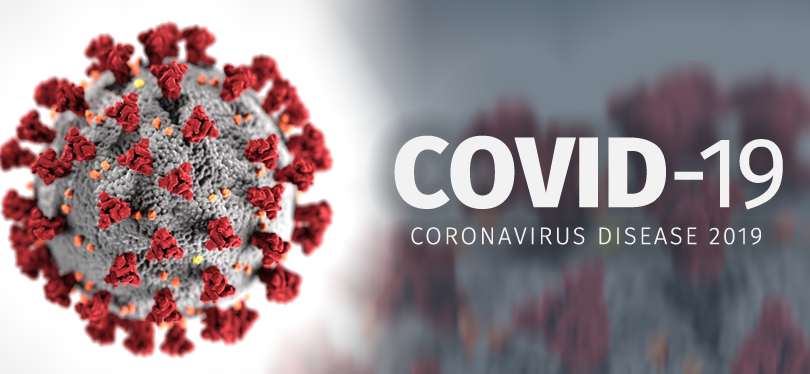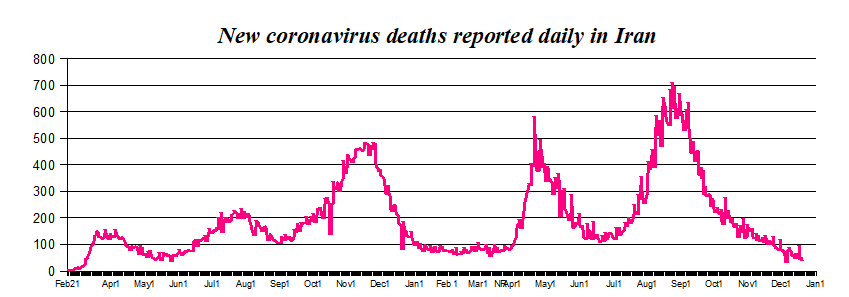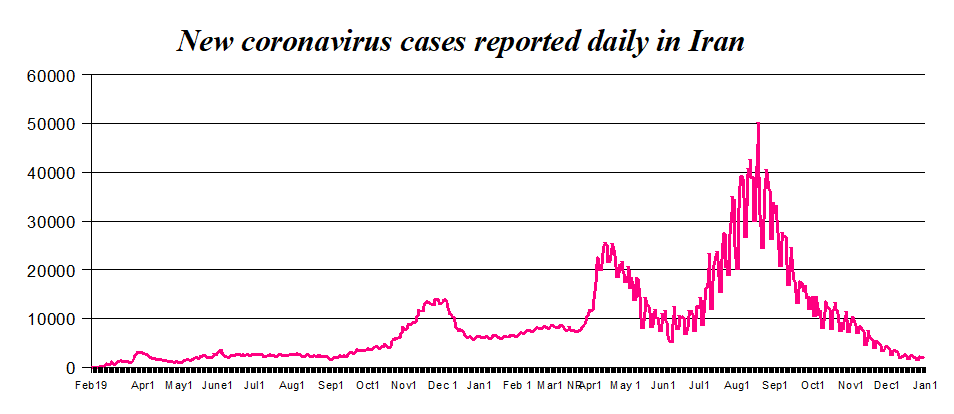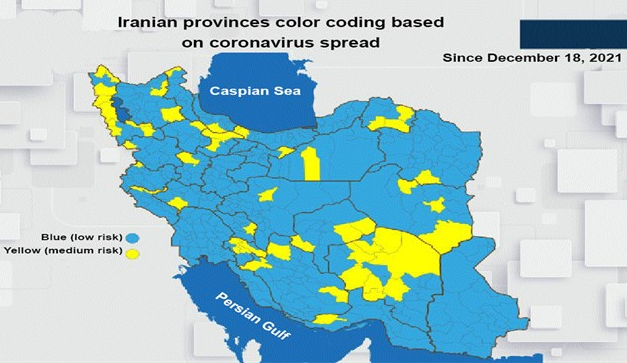December 31, 2021
by Warren L. Nelson


being reported are now below all the numbers seen since the opening weeks of
the epidemic in the spring of 2020. But the Health Ministry warns that the
numbers are likely to soar very soon.

The Times said Chinese vaccines which account for more than 85 percent of all inoculations given in Iran “offer almost zero protection from Omicron infection.”
On the other hand, the good news is that all vaccines appear to do a good job of protecting against serious cases of Covid-19.

(shahrestans) in the extremely high risk (red) or high risk (orange) categories.
But the Times said the only vaccines that so far have stopped Omicron outright are the American-made Pfizer and Moderna shots, which Supreme Leader Ali Khamenehi has forbidden from being imported into Iran.
But just before Omicron was detected in Iran, the country was looking better than ever in its battle against the epidemic. As of December 18, the color coding of Iran’s 448 counties (shahrestans) show zero rated red, meaning the disease is out of control, with 2 percent rated orange or serious, 27 percent rated yellow or under control and 71 percent rated as clear of the disease.
The government said the total of number of deaths had reached 130,992 as of December 17, although the Mojahedin-e Khalq said its survey shows 489,400 deaths as of that date or almost four times as many as officially reported. Death totals in all countries are considered to be under-reported. But many critics in Iran say the statistics there are intentionally suppressed and not just depressed by problems collecting statistics.
Nonetheless, the official figures are believed to show the relative intensity of the epidemic, correctly showing when the epidemic is intensifying and when it is waning. The official figures show the daily death count below 100 every day since December 1, a huge drop from the record high of 709 on August 23. The daily record of new cases topped off at 50,228 on August 17 but has been below 4,000 every day in December and below 2,000 on several recent days.
The government has decided not to mandate vaccinations, but it instituted a new plan December 12 that is intended to encourage people to get vaccinated by saying the unvaccinated will not be permitted to do certain things, such as enter certain buildings or take intercity public transportation. This is supposed to be enforced through a record of whom is vaccinated posted on the internet. Few expect that to work.
The government reopened schools progressively over September, October and November, but is now closing some as cases of the disease are found raging in specific schools. Schools in entire cities, including Tehran, have also been closed on some days because pollution rates have been unusually high for this time of year.
The government stopped importing vaccines in November and said it would shift to domestically-made shots. The Customs Administration said Iran had imported a total of just over 150 million shots, enough to vaccinate 75 million Iranians or more than the planned total of 70 million. (The population now is about 85 million.) The total number of shots administered as of December 20, according to the government’s daily announcements, was just shy of 114 million, so there is no shortage of vaccines available.
The number of first shots administered soared in August and September, but has now slowed considerably. In September, daily doses reached 620,000 per day, according to official figures. But the average in December has been just 76,000 a day.
The total number fully vaccinated with two shots has just passed 50 million. But that is far from the goal of 70 million. With first shots totaling 59 million and daily shots averaging 76,000, it would take until early April for 70 million Iranians to have received just one shot.
The government announced that Iranian-made vaccines would be available at pharmacies for 2 million rials per shot or about $6.50 at the open market exchange rate. This is while the country has been paying $4 per dose for many of its imported shots although the price for the Chinese Sinopharm vaccine, which accounts for 88 percent of the imports, is $9.20 per dose.
When vaccines first appeared, Russia publicly pledged to deliver 60 million shots to Iran, but the Financial Tribune reported that as of mid-November only 4 million shots of the Russian Sputnik 5 vaccine had been received by Iran.
Published figures on how many Iranian-made doses have been produced and delivered vary considerably and are often confused with promises of future deliveries. But Health Minister Bahram Eyenollahi said November 23 that 20 million doses had been produced inside Iran.
